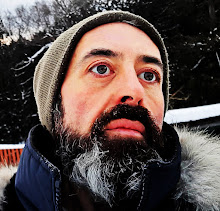2/15/10
In Spring, 30" X 40", acrylic on canvas, Maxim Grunin, 2010
Detail:
I like how acrylics dry in the matter of minutes allowing me to go back into the painting and change things right away. Working on a piece is a building up process. I apply layers of paint marks and these layers often overlap. Some areas of a painting change many times before a piece is finished. The surface of a work can get pretty heavy.
The appearance or the style of my work reflects the medium used to create it and also, it has something to do with my personality. I can start out with a clear idea in mind and even back myself up with a reference. Usually I would have a thumbnail sketch and a photo reference to keep track of what I wanted to appear in my image. No matter how organized I try to be, I still run into my impulsive urge to further experiment with paint as I go along.
In my latest landscape paintings I apply acrylic paint using brushes, palette knives, cut pieces of cardboard and household containers. I mix up batches of color I want to use and dilute them with water. I use a spray bottle and a palette knife to quickly whip up the right viscosity for each paint batch on my palette. This is it, my next goal is to fill an entire canvas not leaving almost any ground showing.
The landscape I am after has a horizon that determines the spatial depth perceived by the viewer. I want anyone who’s looking at my finished piece to feel that there is a sense of distance in the painting. That is why I build that distance into the work right away. I place my paint marks in such way that they appear to recede and become smaller as they move closer to the horizon. The colors I use in the foreground are also much darker and more saturated then the ones further away. Now that I have an illusion of space I can start placing other elements into the picture.
Making a painting is a big job. I need to take breaks and often my work will have to stay on the esil for more then one day before it’s done. At times I would be working on several pieces at once, switching from canvas to canvas without completing any one of them. Working on a body of work together makes me spot good parts of freshly emerging paintings and transfer these better bits onto the pieces that don’t yet seem to work.
I can’t tell if my painting is finished or not the same instant I put down my brushes. Even though I feel I wouldn’t want to add anything to a piece, I can’t be sure it is done. The new painting has to have a chance to grow on me. I put it aside in my studio and take a glance at it every time I turn around or enter the room. This is how I can spot things I don’t like in the piece and rework them. Or I could keep noting how harmonious and together the painting is and learn from it.
Subscribe to:
Post Comments (Atom)



You've made light material.
ReplyDeleteEnjoying your blog.